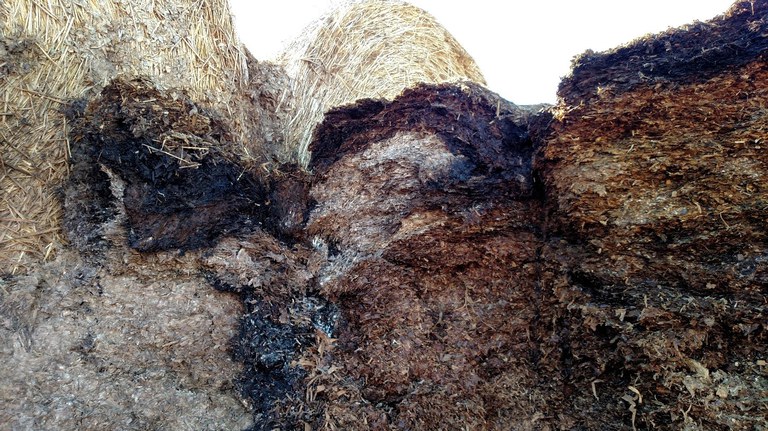Moldy Cattle Feed

Concerns about moldy feeds seem to increase during winter feeding. Moldy feeds are usually a result of harvesting or baling at too high of moisture content. Or in the case of silage, not high enough moisture content to allow for proper fermentation and acid production. Rain and snow can accumulate on feed to create an environment for molds to grow. However, cool temperatures in winter can reduce mold growth.
Grinding hay during winter can result in a hay pile that heats and becomes moldy. Actually, the snow, ice, and rain moisture on the hay bale mixes during grinding. The moistened hay is a great environment for mold growth. When molds grow, heat is produced and eventually feed quality is lost.
A recent feed analysis of a heated hay pile found the total digestible nutrients (TDN) value at 32% dry matter basis. TDN is a measure of feed energy. Normally this hay would have been 52% TDN. Heating resulted in a 40% loss of energy available for the cow.
Cows will readily consume this dark brown colored feed, but don’t be misled. A large portion of the energy in the feed has been lost.
Feed quality can also be judged by the amount of mold on the feed. Mold counts are done by counting colony forming units (CFUs). As mold concentration increases, cattle may decrease feed intake. Feed energy and protein may also decrease with increasing mold counts. Species of mold can also be determined. Certain species are prone to produce toxins.
Be aware of possible mycotoxins present in moldy feeds. Some mycotoxins, like DON or vomitoxin, have practically no feeding issues in beef cattle diets. Other mycotoxins can be very toxic and cause liver damage, abortion, and death.
The NDSU Veterinary Diagnostic lab can analyze for mycotoxin content. http://www.vdl.ndsu.edu/tests
The Mycotoxin LC/MS/MS screen for 12 more common mycotoxins is $158 per sample ($150 plus $8 accession fee).
That same moldy ground hay sample that lost energy content also contained a mycotoxin at extremely low levels:
Be careful in feeding moldy feeds. Testing for feed quality and presence of toxins may be less expensive than the cost of a sick or dead animal.
Karl Hoppe
Area Extension Livestock Specialist


